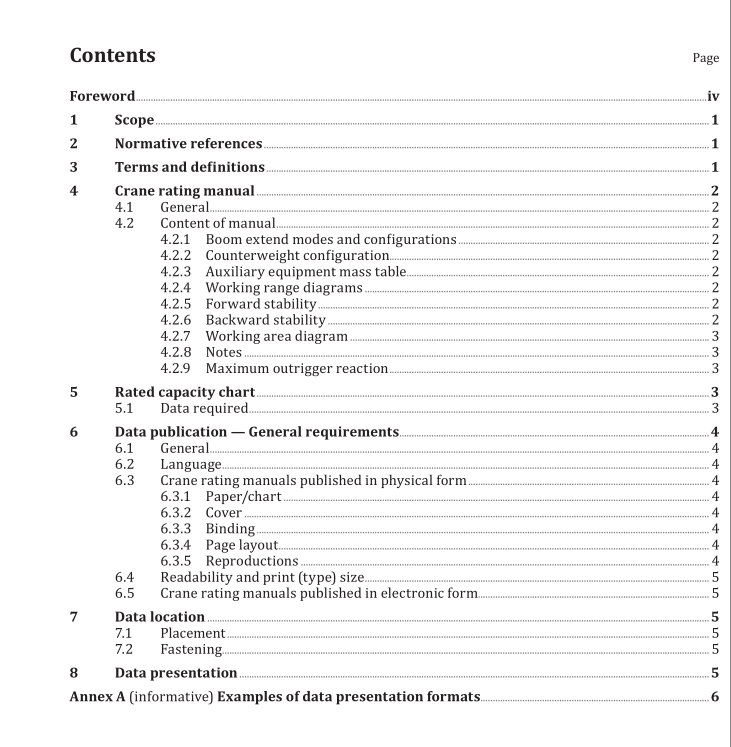ISO 11661:2022 pdf download.Mobile cranes — Presentation of rated capacity charts.
5.1.5 Data deviations
Where necessary, the following deviations are permitted:
a) radius increments are a manufacturer’s option;
b) boom and boom/jib length increments are a manufacturer’s option;
c) the notes and warnings shown on the example rating charts in Annex A are typical of those that may be supplied with many construction cranes. The exact content and wording can vary according to specific use and manufacturer’s requirements. Clear, precise, simple language shall be used.
6 Data publication — General requirements
6.1 General
Rated capacity charts as defined in Clause 4 may be published under one cover in the crane rating manual, separately or in any combination. The grouping of documents is dictated by the type of crane involved. Means shall be provided to quickly reference rated capacity charts and other pages within the crane rating manual.
6.2 Language
If the language of the publication is different from the language of the country of origin, the final draft shall be written or edited by a technically competent person who is able to use and translate the language of publication competently.
6.3 Crane rating manuals published in physical form
6.3.1 Paper/chart
For crane rating manuals published in physical form, the rated capacity charts and other pages shall be legible and permanently marked, and shall have reasonable durability when exposed to rain, dampness,water, oil, grease or sunlight, and temperatures between −40 °C and 60 °C.
6.3.2 Cover
When required, the cover shall have a reasonable durability when exposed to rain, dampness or grease.
The cover shall be of an appropriate size to protect the internal pages.
6.3.3 Binding
The binding or binders shall be appropriate and durable for the intended usage.
6.3.4 Page layout
Typography shall be such that information is clearly legible under normal lighting conditions with normal or corrected vision. Illustrations shall be located on the same pages or as close as possible to their references. The pages shall be numbered consecutively beginning with the left-hand page.
Alternatively, a group numbering system may be used to permit intermediate additions or revisions as appropriate. Headings and sub-headings shall be used for easy reference.
6.3.5 Reproductions
The method of reproduction shall be such that the text and illustrations resist fading and smearing.
6.4 Readability and print (type) size
The type shall be definite and legible. Alphanumeric characters used on the rated capacity charts and other pages of the crane rating manual shall be no less than 8-point font size.
6.5 Crane rating manuals published in electronic form
The device used to display the rating manual shall be such that information is clearly legible either indaylight or with cab illumination at night for operators with normal or corrected vision.
7 Data location
7.1 Placement
The crane rating manual shall be located such that the operator can view the manual in the front hemisphere of the operator’s visibility. The operator shall have easy access to the crane rating manual for reference.
a) When the physical crane rating manual is permanently affixed in the crane operator’s cabin, it shall be located in the front hemisphere of the operator’s visibility.
b) When the physical crane rating manual is stored out of the front hemisphere of the operator’s visibility, it shall be attached in the operator’s cab such that it can be viewed in the front hemisphere of the operator’s visibility.
c) For the electronic crane rating manual, the device used to display the rating manual shall be such that it can be viewed in the front hemisphere of the operator’s visibility.
7.2 Fastening
The crane rating chart/manual, whether provided in electronic or paper form, shall be fastened to the cabin in such a manner that it cannot be removed without tools.
8 Data presentation
8.1 Annex A shows examples of the various formats used to present the data. For a simple crane or boom arrangement, one or two charts may suffice.
8.2 Examples A.1 and A.2 show different format types for rating charts. They include a title and a list of notes and warnings, informational data, and load ratings. The formats shown are for complex boom/jib combinations and adhere to all the requirements of this document. Example A.3 shows a working range diagram, while Example A.4 presents a working area diagram.ISO 11661 pdf download.
